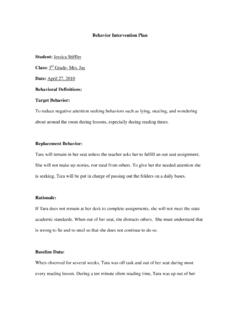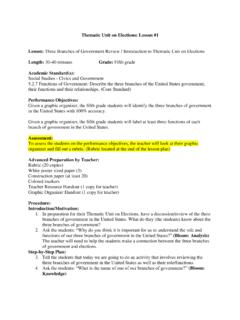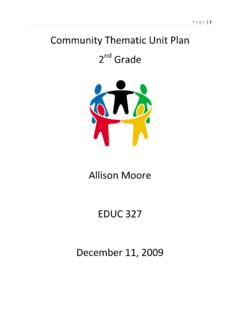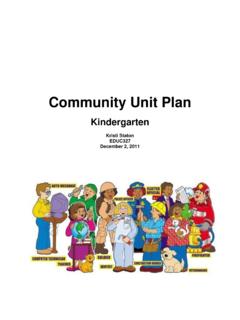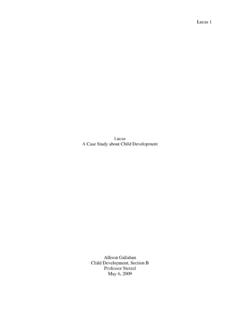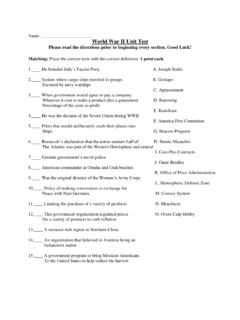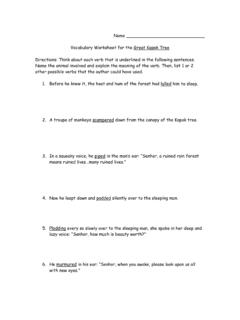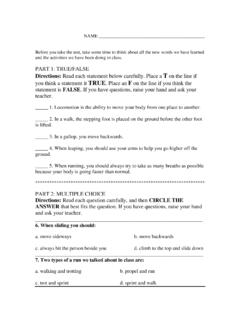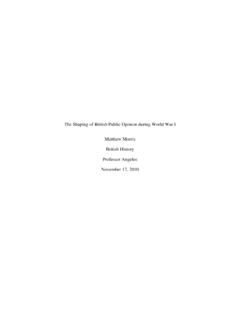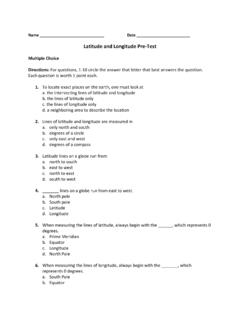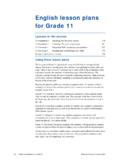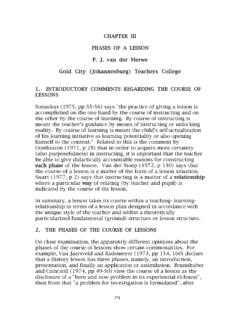Transcription of Civil War Unit Plan Fourth Grade Nicole Short EDUC 327 ...
1 Civil War unit plan Fourth Grade Nicole Short EDUC 327 Fall 2010 Table of Content Introduction Page 1 Standards and Objectives Page 3 unit Web Page 6 Parent Letter Page 7 Trade Books Page 8 Bulletin Board Page 10 Field Trip/ Guest Speaker Page 11 Technology and Literature Page 12 Pretest/ Posttest Page 13 Lesson Plans Page 15 Introduction Grade Level and the Typical Learner: This unit plan is intended for a Fourth Grade class.
2 A typical Fourth grader is about nine or ten years old. Children at age nine can be self-conscious and may not want to work alone on projects and activities. They are at the stage where they are beginning to be able to think abstractly as well as understand cause-and-effect relationships. Children at this age are in the concrete stage of development. At age ten children are getting ready to experience bodily changes and rapid growth due to growth spurts. This is a period where students can become frustrated or angry as a result of these changes.
3 At this age students are interested in learning about places and problems in the news. They are interested in learning what causes the problems and the reasons for them. Rationale: The reasons Fourth graders need to learn about the Civil War is because the Civil War is a large part of our nation s history. Through learning about the Civil War, the unit can meet all of the NCSS standards for Social Studies. By looking at all the different aspects of the Civil War, such as slavery, important individuals and groups of people that had an impact during the war, interaction between these people and groups, and the slave trade, teachers can connect these topics to the NCSS standards.
4 Also by looking at these aspects, the teacher is also meeting the Indiana state standards. These standards look at topics such as impact of individuals and groups on the Civil War and the change in Indiana as a result of the war. Goals of the unit plan : Teach students about the Civil War and its importance in the history of our nation. Teach students the role Indiana played in the Civil War through the use of the Underground Railroad and the role of Abolitionists and anti-slave groups. Allow students to experience the Civil War through a guest speaker presentation.
5 Use literature to enhance students learning on the topic of the Civil War. Teach students how to use technology to help students deepen their learning by searching the internet for more information about the Civil War. Standards and Objectives: Lesson 1: What Side are you On Standard: Social Studies: Places and Regions: Locate Indiana on a map as one of the 50 United States. Identify and describe the location of the state capital, major cities and rivers in Indiana, and place these on a blank map of the state Objectives: Students will color code the map of the United States according to free states, slave states, and territories identifying no more than 3 states incorrectly.
6 Students will determine if Indiana was a free state, slave state, or territory by locating it on the map with 100% accuracy. Lesson 2: To Enslave or Not to Enslave Standard: Social The Civil War Era and Later Development: 1850 to 1900. Explain the roles of various individuals, groups and movements in the social conflicts leading to the Civil War. (Used as a Foundation) Social Studies- Roles of Citizens: Use a variety of information resources to take a position or recommend a course of action on a public issue relating to Indiana's past or present.
7 (Content for assessment) Make informational presentations that: (Assessment) focus on one main topic. include facts and details that help listeners focus. incorporate more than one source of information (including speakers, books, newspapers, television broadcasts, radio reports, or Web sites) Objective: After taking a side, North or South, students will create a debate for or against slavery scoring no lower than a 3 in the content area. Lesson 3: Down on the Farm Standard: SS: The Civil War Era and Later Development: 1850 to 1900.
8 Explain the roles of various individuals, groups and movements in the social conflicts leading to the Civil War. (Foundation of the lesson) Music: Explore music of other cultures through live or recorded authentic performances and the role of music and musicians related to the cultures and times. (Foundation of the lesson) English: Write for different purposes (information, persuasion, description) and to a specific audience or person. (Assessment) Objective: After listening to an example of a slave work song, the students will write the lyrics to their own work song describing work they do during the day scoring 3 in all categories.
9 Lesson 4: What s the plan ? Standard: SS: The Civil War Era and Later Development: 1850 to 1900. Explain the roles of various individuals, groups and movements in the social conflicts leading to the Civil War. (Foundation of lesson) Math: Identify, describe and draw parallelograms, rhombuses, and trapezoids, using appropriate mathematical tools and technology. (Assessment) Objective: After learning about quilt patterns used as ways to escape from the South, students will create a quilt square using geometric shapes to make a pattern.
10 Lesson 5: Underground Railroad Standard: Social Studies: The Civil War Era and Later Development: 1850 to 1900. Explain the roles of various individuals, groups and movements in the social conflicts leading to the Civil War Objectives: After learning about the Underground Railroad, students will design their own stop of the Underground Railroad including places to hide slaves and how to get them to the next stop. After completing their design, students will write a description of their Underground Railroad stop describing how it will be utilized with vivid detail.
